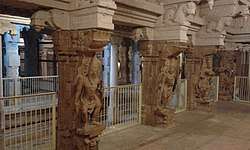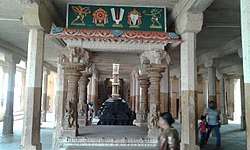Alwarthirunagari Temple
| Alwarthirunagari Temple | |
|---|---|
 | |
 Location in Tamil Nadu | |
| Geography | |
| Coordinates | 8°35′N 77°57′E / 8.583°N 77.950°ECoordinates: 8°35′N 77°57′E / 8.583°N 77.950°E |
| Country | India |
| State | Tamil Nadu |
| District | Thoothukudi |
| Location | Alwarthirunagari |
| Culture | |
| Sanctum |
Aathi Nathar (Lakshmi) |
| Temple tank | Brahma |
| Tower | Govinda |
| Architecture | |
| Architecture | Dravidian architecture |
Alwarthirunagari Permual Temple is one of the Nava Tirupathi, in Alwar Thirunagari, a town in Thoothukudi district in the South Indian state of Tamil Nadu, is dedicated to the Hindu god Vishnu. It is located 26 km from Tirunelveli. Constructed in the Dravidian style of architecture, the temple is glorified in the Divya Prabandha, the early medieval Tamil canon of the Azhwar saints from the 6th–9th centuries AD. It is one of the 108 Divyadesam dedicated to Vishnu, who is worshipped as Adinathar and his consort Lakshmi as Athinathanayagi.[1] The temple is also classified as a Navatirupathi, the nine temples revered by Nammazhwar located in the banks of Tamiraparani river. The temple is the most prominent among the nine Navatirupathi temples. The temple is one of the Navagraha temples in Vaishnavism, associated with Jupiter, the Guru.
A granite wall surrounds the temple, enclosing all its shrines and two of its three bodies of water. The rajagopuram, the temple's gateway tower, is 95 ft (29 m) tall. The temple is considered the birthplace of Nammazhwar, considered the most prominent among the twelve Azhwar Saints. The temple follows Thenkalai tradition of worship. Six daily rituals and three yearly festivals are held at the temple, of which the ten-day annual Brahmotsavam during the Tamil month of Chittirai (April - May) and the Nammazhwar birth celebrations with Garudasevai with all nine temple of Navatirupathi, being the most prominent. The temple is maintained and administered by the Hindu Religious and Endowment Board of the Government of Tamil Nadu.
Legend

Alwar Tirunagari is believed to be the largest town in the time of Pandya kings. The distinguishing name, with azhwar in Tamil prefixed to Thirunagarimeans the people who spoke languages first and speaks correct language.[2] The temple is considered the birthplace of Nammazhwar, considered the most prominent among the twelve Azhwar Saints. Nammazhwar has contributed more than thousand verses out of the four thousand in Nalayira Divya Prabhandam, the Vainava canon.[3]
According to traditional scriptures, Nammazhwar was born in 43rd Kali of 3059 BC.[4] He was born in a ((velalar)) family at Thirukuravur(modern day Alwarthirunagiri) in the southernmost region of the Tamil country.[5][6] According to legend, as a child he responded to no external stimuli and his parents left him at the feet of the deity of Sri Adhinathar of Nagar tribe in Alwarthirunagari. The child then got up and climbed into a hole in a tamarind tree, sat in the lotus position, and began to meditate. It appears he was in this state for as long as sixteen years when a Tamil poet and scholar in Madurai named Madhurakavi Alvar saw a bright light shining in the south, and followed it until he reached the tree where the boy was residing. Unable to elicit any reaction from the child, he asked him a riddle: "If the small is born in a dead's body (or stomach), what will it eat and where will it stay?" meaning, if the subtle soul is embodied in the gross body, what are its actions and thoughts? Nammalvar broke his lifelong silence and responded, "That it will eat, it will rest!" meaning that if the soul identifies with the body, it will be the body but if it serves the divine, it will stay in vaikunta and eat(think) of God.[7] Madhurakavi Alvar realized the divinity of this child and became a devotee of the child. The works of Nammalwar were compiled by Madhurakavi as four different works, the Tiruvayumoli (1102 verses), Thiruviruttam (100 verses), Thiruvaasiriam (or Thiru Aasiriyam - 7 verses) andPeriya Thiruvanthadi (87 verses). The works of Nammalwar contributed to the philosophical and theological ideas of Vaishnavism. Along with the three samaya kuravargal, Shaiva Nayanars Appar, Sundarar and Sambandar, they influenced the ruling Pallava kings of South India, changing the religious geography from Buddhism and Jainism to Hinduism.[8][9][10]
Religious significance

Brahmanda Purana one of the eighteen sacred texts of Hinduism and written by Veda Vyasa contains a chapter called Navathirupathi Mahatmeeyam. The second part of the chapter refers to Alwar Thirunagari.[11] The temple is revered in Nalayira Divya Prabandham, the 7th–9th century Vaishnava canon, by Nammazhwar. The temple is classified as a Divyadesam, one of the 108 Vishnu temples that are mentioned in the book. The temple is also classified as a Navatirupathi, the nine temples revered by Nammazhwar located in the banks of Tamiraparani river. The temple is the most prominent among the nine Navatirupathi temple.[11][12] Nammazhwar makes a reference about the temple in his works in Thiruvaimozhi. During the 18th and 19th centuries, the temple finds mention in several works like 108 Tirupathi Anthathi by Divya Kavi Pillai Perumal Aiyangar. The temple also forms a series of Navagraha temples where each of the nine planetary deities of one of the temples of Navatirupathi. The temple is associated with the planet Jupiter, called Guru.[13][14][15]
Festival and religious practices

The Garuda Sevai utsavam(festival) in the month of Vaikasi(May-Jun) witnesses nine Garudasevai, a spectacular event in which festival image idols from the Nava Tirupathis shrines in the area are brought on Garuda vahana(sacred vehicle). An idol of Nammalvar is also brought here on an Anna Vahanam (palanquin) and his paasurams (verses) dedicated to each of these nine temples are recited. The utsavar(festival deity) of Nammalvar is taken in a palanquin to each of the nine temples, through the paddy fields in the area. The paasurams(poems) dedicated to each of the nine divya desams are chanted in the respective shrines. This is the most important of the festivals in this area, and it draws thousands of visitors.
The temple follows the traditions of the Thenkalai sect of Vaishnavite tradition and follows Pancharathra aagama. The temple priests perform the pooja (rituals) during festivals and on a daily basis. As at other Vishnu temples of Tamil Nadu, the priests belong to the Tamil non Brahmin Vainavaite.The temple rituals are performed four times a day: Kalasanthi at 8:00 a.m., Uchikalam at 12:00 p.m., Sayarakshai at 6:00 p.m., and Ardha Jamam at 8:00 p.m. Each ritual has three steps: alangaram (decoration), neivethanam (food offering) and deepa aradanai (waving of lamps) for both Adinathar and Athinathanayagi. During the last step of worship, nagaswaram (pipe instrument) and tavil (percussion instrument) are played, religious instructions in the Vedas (sacred text) are recited by priests, and worshippers prostrate themselves in front of the temple mast. There are weekly, monthly and fortnightly rituals performed in the temple.[12]
Notes
- ↑ M. S., Ramesh (1993). 108 Vaishnavite Divya Desams: Divya desams in Pandya Nadu. Tirumalai-Tirupati Devasthanam. .
- ↑ Annual report of the Archaeological Department, Southern Circle, Madras. By Archaeological Survey of India.
- ↑ V., Meena. Temples in South India. Kanniyakumari: Harikumar Arts. pp. 6–7.
- ↑ M. Srinivasachariar (1974). History of Classical Sanskrit Literature: Being an Elaborate Account of All Branches of Classical Literature, with Full Epigraphical and Archaeological Notes and References, an Introduction Dealing with Language, Philology, and Chronology, and Index of Authors & Works. Motilal Banarsidass Publisher. pp. 278–. ISBN 978-81-208-0284-1.
- ↑ Sadarangani, Neeti M. (2004). Bhakti Poetry in Medieval India: Its Inception, Cultural Encounter and Impact. Sarup & Sons. p. 28. ISBN 9788176254366.
- ↑ Carman, John B. (1994). Majesty and Meekness: A Comparative Study of Contrast and Harmony in the Concept of God. Wm. B. Eerdmans Publishing. pp. 64–65. ISBN 9780802806932.
- ↑ Swami, Parmeshwaranand (2001). Encyclopaedic Dictionary of Purāṇas. Sarup & Sons. p. 908. ISBN 9788176252263.
- ↑ B.S. 2011, pp. 47-48
- ↑ Mukherjee (1999). A Dictionary of Indian Literatures: Beginnings-1850 Volume 1 of A Dictionary of Indian Literature, A Dictionary of Indian Literature. Orient Blackswan. p. 15. ISBN 9788125014539.
- ↑ Garg, Gaṅgā Rām (1992). Encyclopaedia of the Hindu World: Ak-Aq. Concept Publishing Company. pp. 352–354. ISBN 9788170223757.
- 1 2 M., Rajagopalan (1993). 15 Vaishnava Temples of Tamil Nadu. Chennai, India: Govindaswamy Printers. pp. 155–159.
- 1 2 "Sri Aadinaathan temple". Dinamalar. 2014. Retrieved 31 May 2014.
- ↑ "Amazing posture at Srivaikuntam". The Hindu. 15 November 2001. Retrieved 25 October 2015.
- ↑ Suriya (2015). Jothirlingam: The Indian Temple Guide. Partridge Publishing. p. 30. ISBN 9781482847864.
- ↑ Anantharaman, Ambujam (2006). Temples of South India. East West Books (Madras). pp. 33–43. ISBN 978-81-88661-42-8.
References
- B. S., Chandrababu; S., Ganeshram; C., Bhavani (2011). History of People and Their Environs. Bharathi Puthakalayam. ISBN 9789380325910.
External links
| Wikimedia Commons has media related to Azhwar Thirunagari. |